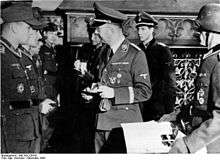Karl Radermacher
| Karl Radermacher | |
|---|---|
| Born |
12 December 1922 Aachen |
| Died | 9 October 2016 (aged 93) |
| Allegiance |
|
| Service/branch | Heer |
| Years of service | 1942–45 |
| Rank | Leutnant |
| Unit | Grenadier-Regiment 45 |
| Battles/wars | |
| Awards | Knight's Cross of the Iron Cross |
Karl Radermacher (12 December 1922 – 9 October 2016) was a Leutnant in the Heer during World War II. He was also a recipient of the Knight's Cross of the Iron Cross. The Knight's Cross of the Iron Cross was awarded to recognise extreme battlefield bravery or successful military leadership. He was also awarded the very rare Close Combat Clasp in Gold one of only 631 awards.
Career

Radermacher was born on 12 December 1922 in Aachen, the son of an ice-cream vendor. After an apprenticeship as an electrician and mechanic, and member of the Hitlerjugend, he was drafted into the Army in March 1942. After a short basic training, Radermacher was transferred to the Eastern Front in the summer of 1942. His first combat experience came with his Grenadier Regiment 45, which was part of the 21 Infantry Division, at the Leningrad front. He was later promoted to squad leader and, in October 1942, he was awarded the Iron Cross Second Class and the Infantry Assault Badge in silver. With his 6th Company, he was wounded, and returned after a short hospital stay back to the company on the Leningrad front. During the subsequent withdrawal he was wounded again. After returning to the front he was used as a battalion messenger and gave the alarm company and platoon commanders in the middle of combat important messages. For this he received the Iron Cross First Class in February 1944.
In the early summer of 1944 the regiment was in a fixed position, expecting every moment to be the impending enemy offensive. Constant patrols, apparent attacks, and persistent probing of the front by Russians denied the German soldiers any rest and the ability to find the enemies weak point at the front. The enemy managed to infiltrate the German position on the flank of the Second Battalion and fierce hand-to-hand combat ensued. Radermacher was placed with his group in the middle section and led the resistance, after all of the officers and sergeants had failed. As the enemy retired after heavy losses, Radermacher pulled together some of his comrades and led a counterattack, where he added still further heavy losses to the enemy. This brought the fighting front noticeable relief. For his combat leadership he was awarded the Knight's Cross, as one of the lowest rank of the German Wehrmacht on 05.04.1944, as a private and mortar squad leader.
Later promoted to sergeant, Radermacher already had more than 40 close combat days to his credit. As leader of the 2nd platoon of the 6th Company, Radermacher took part in the fighting in the Baltic region and the first Kurlandschlachten. Here he received the news of the award of the Close Combat Clasp in Gold. After this ceremony Radermacher, as a recognized specialist in close combat command, was appointed a cadet sergeant and transferred to the officer training school in Potsdam. The Golden Close Combat Clasp was awarded to him in person two months later. Together with 82 other soldiers of the Heer and the Waffen-SS, he received the award on 12 December 1944, presented at the City Council of Ulm by Reichsführer SS Heinrich Himmler in person. Furthermore, the presentation of the award came the promotion to Lieutenant. Along with the presentation of the Close Combat Clasp, he was also presented with the German Cross in Gold.
In early 1945, Radermacher was part of an alarm group fighting the war on the Oder front, near Frankfurt on the Oder, where he was wounded again. After the war Radermacher became a grocer and retired in 1987 after 25 years as a bank employee. He died in October 2016 at the age of 93.[1]
Awards and decorations
- Iron Cross (1939)
- 2nd Class (10 December 1942)
- 1st Class (14 February 1944)
- Wound Badge (1939)
- in Black
- in Silver
- Close Combat Clasp
- in Bronze
- in Silver
- in Gold (21 October 1944)
- Knight's Cross of the Iron Cross on 4 May 1944 as Gefreiter and Granatwerfertruppführer in the 6./Grenadier-Regiment 45[2]
- German Cross in Gold on 27 November 1944 as Feldwebel in the 6./Grenadier-Regiment 45[3]
References
- ↑ http://www.kirche-daun.de/7_aktuel/downloads/pfarrbrief.pdf
- ↑ Fellgiebel 2000, p. 283.
- ↑ Patzwall & Scherzer 2001, p. 364.
Bibliography
- Berger, Florian (2004). Ritterkreuzträger mit Nahkampfspange in Gold [Knight's Cross Bearers with the Close Combat Clasp in Gold] (in German). Vienna, Austria: Selbstverlag Florian Berger. ISBN 978-3-9501307-3-7.
- Fellgiebel, Walther-Peer (2000) [1986]. Die Träger des Ritterkreuzes des Eisernen Kreuzes 1939–1945 — Die Inhaber der höchsten Auszeichnung des Zweiten Weltkrieges aller Wehrmachtteile [The Bearers of the Knight's Cross of the Iron Cross 1939–1945 — The Owners of the Highest Award of the Second World War of all Wehrmacht Branches] (in German). Friedberg, Germany: Podzun-Pallas. ISBN 978-3-7909-0284-6.
- Patzwall, Klaus D.; Scherzer, Veit (2001). Das Deutsche Kreuz 1941 – 1945 Geschichte und Inhaber Band II [The German Cross 1941 – 1945 History and Recipients Volume 2] (in German). Norderstedt, Germany: Verlag Klaus D. Patzwall. ISBN 978-3-931533-45-8.
- Scherzer, Veit (2007). Die Ritterkreuzträger 1939–1945 Die Inhaber des Ritterkreuzes des Eisernen Kreuzes 1939 von Heer, Luftwaffe, Kriegsmarine, Waffen-SS, Volkssturm sowie mit Deutschland verbündeter Streitkräfte nach den Unterlagen des Bundesarchives [The Knight's Cross Bearers 1939–1945 The Holders of the Knight's Cross of the Iron Cross 1939 by Army, Air Force, Navy, Waffen-SS, Volkssturm and Allied Forces with Germany According to the Documents of the Federal Archives] (in German). Jena, Germany: Scherzers Miltaer-Verlag. ISBN 978-3-938845-17-2.